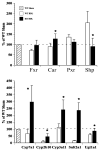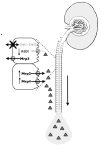Organic solute transporter, OSTalpha-OSTbeta: its role in bile acid transport and cholestasis
- PMID: 20422499
- PMCID: PMC3713633
- DOI: 10.1055/s-0030-1253226
Organic solute transporter, OSTalpha-OSTbeta: its role in bile acid transport and cholestasis
Abstract
Organic solute transporter alpha-beta (OSTalpha-OSTbeta) is a unique heteromeric transporter localized to the basolateral membrane of epithelial cells involved in sterol transport. It is believed to be the primary bile acid efflux transporter in the intestine of mammals and is therefore essential to bile acid homeostasis and the enterohepatic circulation. First described in the evolutionarily primitive small skate, LEUCORAJA ERINACEA, this facilitated transporter requires expression of both subunits for its function. It can transport a variety of bile acids, as well as estrone 3-sulfate, dehydroepiandrosterone 3-sulfate, digoxin, and prostaglandin E (2). Expression of both subunits is variable between species and tissues; in humans high expression is noted in the liver, small intestine, kidney, testis, and adrenal gland. OSTalpha-OSTbeta is directly regulated by the bile acid sensing nuclear receptor, farnesoid X receptor (FXR). Furthermore, it is part of the complex regulatory pathway that controls bile acid synthesis and homeostasis. Hepatic OSTalpha-OSTbeta is upregulated in cholestasis in both humans and rodents, where it appears to play a protective role. Additional studies are necessary to determine its role in liver injury, bile acid malabsorption, and lipid and glucose metabolism, as well as a potential protective role for kidney OSTalpha-OSTbeta in cholestasis.
Figures


Similar articles
-
Upregulation of a basolateral FXR-dependent bile acid efflux transporter OSTalpha-OSTbeta in cholestasis in humans and rodents.Am J Physiol Gastrointest Liver Physiol. 2006 Jun;290(6):G1124-30. doi: 10.1152/ajpgi.00539.2005. Epub 2006 Jan 19. Am J Physiol Gastrointest Liver Physiol. 2006. PMID: 16423920
-
Pleiotropic functions of the organic solute transporter Ostα-Ostβ.Dig Dis. 2011;29(1):13-7. doi: 10.1159/000324123. Epub 2011 Jun 17. Dig Dis. 2011. PMID: 21691099 Free PMC article. Review.
-
The heteromeric organic solute transporter alpha-beta, Ostalpha-Ostbeta, is an ileal basolateral bile acid transporter.J Biol Chem. 2005 Feb 25;280(8):6960-8. doi: 10.1074/jbc.M412752200. Epub 2004 Nov 24. J Biol Chem. 2005. PMID: 15563450 Free PMC article.
-
OSTalpha-OSTbeta: a major basolateral bile acid and steroid transporter in human intestinal, renal, and biliary epithelia.Hepatology. 2005 Dec;42(6):1270-9. doi: 10.1002/hep.20961. Hepatology. 2005. PMID: 16317684
-
Advances in understanding the regulatory mechanism of organic solute transporter α-β.Life Sci. 2022 Dec 1;310:121109. doi: 10.1016/j.lfs.2022.121109. Epub 2022 Oct 18. Life Sci. 2022. PMID: 36270426 Review.
Cited by
-
Bile acid transporter-mediated oral drug delivery.J Control Release. 2020 Nov 10;327:100-116. doi: 10.1016/j.jconrel.2020.07.034. Epub 2020 Jul 22. J Control Release. 2020. PMID: 32711025 Free PMC article. Review.
-
miRNA-382-5p Suppresses the Expression of Farnesoid X Receptor to Promote Progression of Liver Cancer.Cancer Manag Res. 2021 Oct 22;13:8025-8035. doi: 10.2147/CMAR.S324072. eCollection 2021. Cancer Manag Res. 2021. PMID: 34712060 Free PMC article.
-
Dietary intake of bioactive ingredients impacts liver and adipose tissue transcriptomes in a porcine model of prepubertal early obesity.Sci Rep. 2020 Mar 25;10(1):5375. doi: 10.1038/s41598-020-62320-4. Sci Rep. 2020. PMID: 32214182 Free PMC article.
-
Characterization of a novel organic solute transporter homologue from Clonorchis sinensis.PLoS Negl Trop Dis. 2018 Apr 27;12(4):e0006459. doi: 10.1371/journal.pntd.0006459. eCollection 2018 Apr. PLoS Negl Trop Dis. 2018. PMID: 29702646 Free PMC article.
-
Versatile Triad Alliance: Bile Acid, Taurine and Microbiota.Cells. 2022 Jul 29;11(15):2337. doi: 10.3390/cells11152337. Cells. 2022. PMID: 35954180 Free PMC article. Review.
References
-
- Wong MH, Oelkers P, Craddock AL, Dawson PA. Expression cloning and characterization of the hamster ileal sodium-dependent bile acid transporter. J Biol Chem. 1994;269(2):1340–1347. - PubMed
-
- Seward DJ, Koh AS, Boyer JL, Ballatori N. Functional complementation between a novel mammalian polygenic transport complex and an evolutionarily ancient organic solute transporter, OSTalpha-OSTbeta. J Biol Chem. 2003;278(30):27473–27482. - PubMed

